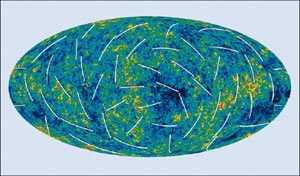NASA’s Wilkinson Microwave Anisotropy Probe (WMAP) collaboration has finally released new observations of cosmic microwave background (CMB) radiation with updated results on the nature and origin of the universe. Three times more data and improved analyses give strong constraints on all cosmological parameters and provide evidence supporting the inflation scenario.

The long silence following the release of the first-year WMAP results in February 2003
(see CERN Courier April 2003 p11) has been the subject of much speculation. Did the team find a problem affecting these results? Did they find something extraordinary? Are they in great trouble with instrumental effects or foreground emission for which they cannot properly account? In fact none of these was the case, the WMAP science team simply wanted to have the most reliable results to be published together. This eventually happened without much prior notice on 16 March at 1700h GMT. Within minutes, the press release, images and the four scientific papers were all available on the Web. In view of the amount of information in the 280 pages submitted to the Astrophysical Journal, it is easy to see that this could not have been prepared much faster.

The addition of two years of observations did not lead to a revolution in the field, but rather confirmed and refined the results of the first year. As well as the CMB’s thermal fluctuations, the complementary polarization data have now been released. Combining the WMAP data with all kinds of other observational constraints from different missions and experiments, it seems that the main cosmological parameters are now well determined assuming cold dark matter (CDM) together with a cosmological constant (ΔCDM).
Specifically, the universe is 13.8 billion years old and its current expansion rate is characterized by a Hubble constant, H0 = 71±2 km/s/Mpc. Baryonic matter (basically atoms) constitutes only 4.4±0.3% of the matter-energy content of the universe, the rest being CDM of unknown nature (22±2%) and dark energy (74±2%). The combination of data from WMAP and the Supernova Legacy Survey gives a strong constraint on the equation of state of dark energy, w = -0.97±0.08, which leaves not much freedom for something – like phantom energy if w<-1 or quintessence if w>-1 – other than a pure cosmological constant (see CERN Courier May 2003 p13). This result does not rely much on the assumption of a spatially flat universe, which is well confirmed by the observations anyway. The epoch of re-ionization by the first stars is now found to be at a redshift of 7-12 , which is later by a factor of two than suggested by the earlier data. Finally, the results yield an upper limit of 0.68 eV for the sum of the neutrino masses.
What is really new in these latest results is the ability to constrain inflation models based on the full-sky polarization map. According to the inflationary scenario, the origin of the CMB fluctuations are quantum fluctuations scaled up by a factor of 1030 during the first instants (∼10-34 s) after the Big Bang. In the simplest inflationary models this would lead to a roughly scale-invariant spectrum of density fluctuations corresponding to a power-law index of n = 1 or slightly less. This is exactly what was found with the new WMAP data, which yield n = 0.94±0.02, showing a small but significant deviation from scale invariance in the sense that the largest-sized fluctuations are the strongest. The opposite behaviour was predicted by more complicated hybrid models, which now appear to be ruled out. This result also implies that primordial gravitational waves would have a relatively high amplitude not far below the current detection threshold. Detecting their signature in the CMB polarization map would be a stunning confirmation of inflation and is therefore an important goal for ESA’s Planck mission to be launched in 2008.
Further reading
Papers of the three-year WMAP observations have been submitted to the Astrophysical Journal and are available at http://map.gsfc.nasa.gov/m_mm/pub_papers/threeyear.html.





